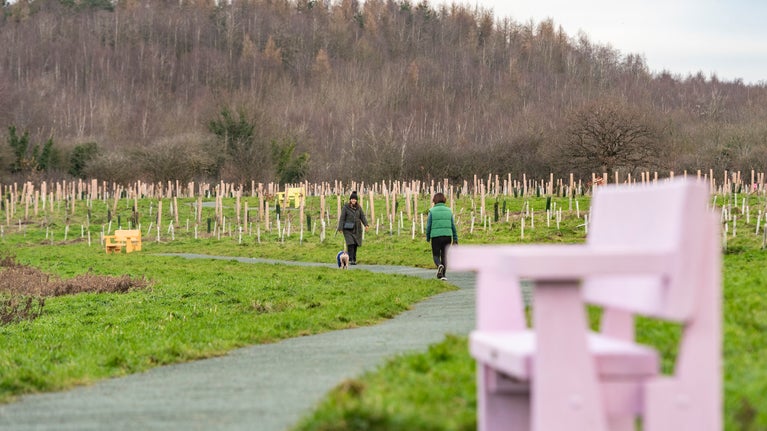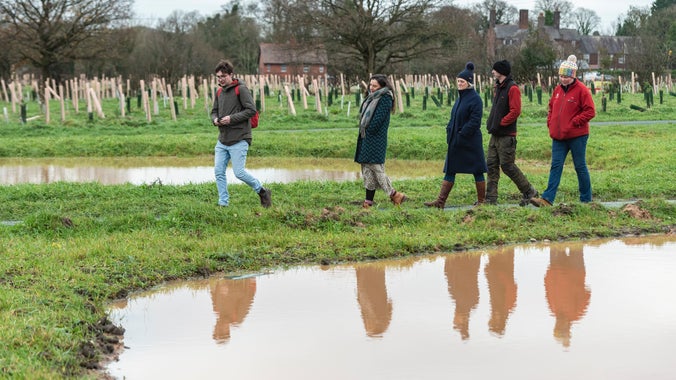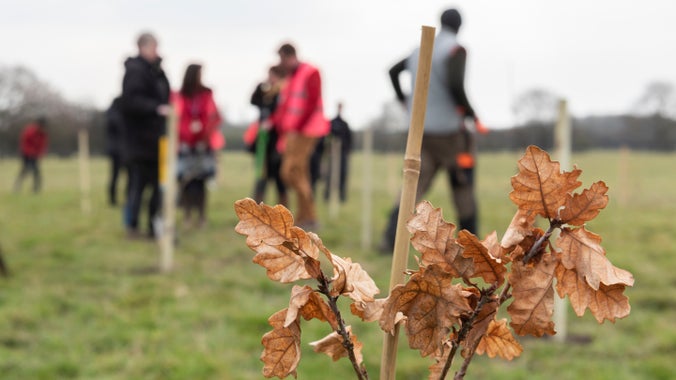
Discover more in Wales
A Celtic land with an industrial past steeped in myth, legend, poetry and song. Croeso i Gymru.

We're proud to be the location of one of Wales’ three new commemorative woodlands that stands as living memorials to those who have sadly lost their lives during the Covid-19 Pandemic.
The Hafod y Bwch Commemorative Woodland, part of the Welsh Government’s National Forest Programme, offers a space for reflection to remember those lost to COVID-19 while also creating a green space for all to enjoy.
Spanning nine hectares on the southern edge of the Erddig estate, this safe and accessible woodland invites visitors to honour loved ones and connect with nature in a peaceful environment.
The woodland stands as a space for remembrance, reflection and ongoing connection with the natural world. With its theme of ‘resilience’- a tribute to the strength shown by the people of Wales it serves not only as a memorial but also as a symbol of hope and renewal.
The woodland will play a vital role in supporting nature’s recovery and combating the climate crisis. Now open to the public, it invites everyone to come together, enjoy its beauty, and witness its growth for generations to come.

The design of the woodland was shaped by community input, with the goal of creating a space for both people and nature. Following community engagement sessions and input from stakeholders, several key requirements emerged, which guided the creation of distinct zones, each with its own specific focus:
At the heart of the woodland a large grassland meadow provides an open-air social space for picnics, events and activities. In the summer months mown paths create an immersive experience for visitors as wildflowers bloom.
People are encouraged to explore nature in a natural play zone at the corner of the site.
A permanent community space includes an orchard full of fruit trees is set to blossom in spring and provide fruit to pick in autumn.
For those seeking solitude a special quiet zone gives space for contemplation with a water feature for a focal point.
Flat, wide accessible paths suitable for wheelchairs, trampers and buggies connect the different zones. Existing footpaths give pedestrian access and allow for exploration of the surrounding countryside.
Colourful benches reflecting the local plant life provide inviting spots to sit and relax.
Bike racks at the main entrance are available for cyclists.

Small, wooded sections on the edge of the site are densely planted and left entirely for wildlife. Trees and shrubs provide much-needed homes and nesting spots for birds and mammals, while also helping reduce noise and pollution from the neighbouring road.
Tree species in the woodland have been chosen for their ability to adapt to the threats of pests, diseases and a changing climate, with the majority being native broadleaf varieties historically and culturally linked to the area.
A second meadow acts as a food source for pollinators and protects evidence of a historical ridge and furrow meadow. Scattered ponds, hedgerows, and wooded glades add to the variation of vital habitats, allowing amphibians, mammals and birds to thrive.

The woodland space at Erddig is commemorative in its entirety and we do not intend to have individually dedicated trees. This is because woodlands are dynamic, living systems that are actively managed. In order for them to thrive we will sometimes need to remove trees for safety and to make space for the woodland to mature.
The commemorative woodland project forms part of the Welsh Government’s National Forest Programme. The National Forest comprises a network of publicly accessible woodlands under high quality management across Wales, to include both new and existing woodlands. Community engagement will be at the forefront of the development of National Forest sites to help ensure the woodlands provide opportunities for recreation, education, and exercise and in this case, also a place for reflection to remember those lost to Covid-19.
Two further commemorative woodlands have been created in partnership with the Welsh Government: Natural Resources Wales’ Brownhill in Carmarthenshire and Caerphilly County Borough Council’s Ynys Hywel.
Visit and discover the beauty of this commemorative woodland:
Hafod Y Bwch Commemorative Woodland, Hafod Road, Wrexham, LL14 6HF

A Celtic land with an industrial past steeped in myth, legend, poetry and song. Croeso i Gymru.
National Trust Cymru have shared the final design of one of Wales’ new commemorative woodlands at Erddig near Wrexham. People are being invited to help plant trees at the woodland which will be a living memorial to those who have sadly lost their lives during the Covid-19 Pandemic.
